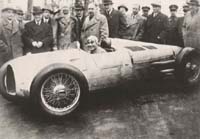Auto Union - The history of the AU racing department
Part 1: The small workshop that created motor racing history (1931-1935)
Author
- Holger Merten (originally written in German, translation by Mattijs Diepraam, with additional help from Richard Armstrong)
Date
- December 2, 2002
Related articles
- The early Auto-Unions - From P-Wagen to A-type, by Leif Snellman
- Auto Union Type E - The stillborn 1.5-litre car: why it (almost) did exist, by Jeroen Bruintjes
- Sokol 650 - Post-war Auto Union in disguise or a socialist F2 effort? Secrets of Tom Wheatcroft's "Type E" unveiled, by Jeroen Bruintjes/Holger Merten
- Part 1: To Moscow and back
- Part 2: Through the iron curtain
- Part 3: It's an Awtowelo!
- Part 4: Awtowelo debuts at Goodwood
Why?
This picture shows a happy Hans Stuck after his successful world record attempts on the Avus. Behind him a proud Rennleiter Willy Walb. After these record attempts Auto Union entered all great races on three continents until 1939.
Between 1934 and 1939 Grand Prix racing was dominated by two great marques: the traditional Mercedes-Benz company and the young-at-heart Auto Union, founded in 1932 from a collection of traditional marques. On the one hand you had the Untertrkheim firm that knew the prestigious earnings to be gained through motorsports all too well and therefore wanted - needed - to win at all costs. On the other you had a conglomerate of companies that came about through the interest of the Federal State of Saxony and three firms that owed great amounts of money to the Saxon State Bank - DKW, of which Audi had been a part since 1928, Horch, and the acquisition of the Wanderer factory's car department. It is obvious that in the summer of 1932 the future of this new company remained unforseeable. Which makes it all the more remarkable that shortly afterwards Auto Union would take part in the first of 83 races, winning 42 of them. Responsible for this success were a team of craftsmen and engineers capable of combining their wit, effort and an innovative race car design to form a technically-driven opposition against the might of Stuttgart.
The idea behind the Auto Union racing department goes back further than the foundation of Auto Union. At the 1931 Paris Salon Wanderer director Klee had signed an agreement between Wanderer Werke AG and the Dr.Ing. h.c. F. Porsche GmbH "to develop and build a Wanderer racing car". Through the acquisition of Wanderer's car department the contract was transferred to Auto Union, along with Wanderer board member von Oertzen and all other Wanderer contracts. It's no misrepresentation of history to state that Wanderer manager von Oertzen, the same man who claims the invention of the four-ringed logo, found a staunch ally in Dr. Porsche. As an AIACR member Porsche could not just influence the regulations, he also possessed the mind to get the best out of them. What's more, as an expert in automobile technology, he could dedicate his time to a futuristic new construction.
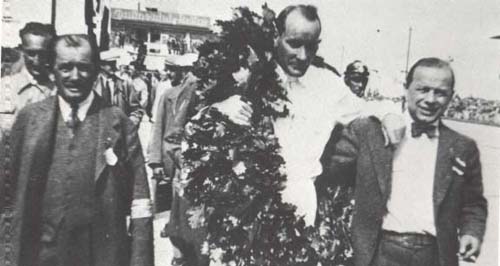
The men responsible for creating Auto Union's success: designer Porsche, driver Stuck,
director von Oertzen, straight after victory at Berne in 1934.
Ferdinand Porsche, who in 1930 had founded his engineering agency in Stuttgart, registered his Hochleistungfahrzeugbau GmbH ("High-Performance Vehicle Construction Ltd") on 8 November 1931, with an initial capital of 30,000 Reichsmarks. Its single purpose was allowing the race car project to grow from the engineering stage to its application on the tracks. Being a member of the AIACR Porsche was able to influence the new Grand Prix formula and knew all of the design requirements, immediately setting about investigating all possible avenues in automobile technology. So his design didn't come out of nowhere but was the result of considerable reflection during his Wanderer days. A mere seven days later, on November 15, Porsche laid out the main foundations of his design in front of his inner circle: a V16 engine of 4.4-litre capacity, blown by a set of Roots superchargers. All of it behind the driver's back. The concept would be received as a sensation, even though it wasn't entirely new to Porsche himself when taking his Mercedes days and his involvement in the Benz Tropfenwagen into account. However, with the sale of the Wanderer car department to Auto Union in 1932 thoughts of creating new racing machines were very much at the back of everyone's minds. This was an age of bitter economic crisis, and it had been this that had forced Auto Union into existence in the first place. And so, when Porsche - contractually bound to Wanderer and consequently to Auto Union - came to present his racing project to the board some five months later, the company management remained aloof. For a while it even considered releasing Porsche from the Wanderer contract that had brought him into the new company.
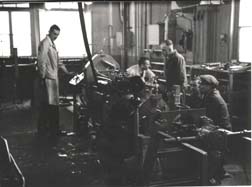 This attitude took an abrupt and momentous about turn after Germany changed its face at a heartbeat. On 30 January 1933 Adolf Hitler was appointed the new Chancellor, and the Führer ohne Führerschein (an untranslatable pun meaning "Leader without a driver's license") was a Friend of the Automobile. This meant that the wahre Grösse Deutschlands ("true greatness of Germany") should also be propagated across the world through its successes on the race track. This was best done by means of the supercharged Mercedes-Benz fanfare, which was promised huge subsidies by Hitler. However, Porsche along with Hans Stuck, whom he knew well and had already been chosen as his driver, was able to put a visit to Hitler to good use - in the presence of von Oertzen he persuaded the Chancellor to split his funds in two. This must have led to some assiduous activity in Zschopau (where the Auto Union headquarters resided at the time) and Zwickau, as suddenly race car construction became a serious matter. On March 17, Porsche and Auto Union agreed on a new deal in which the terms of delivery were set in stone. The car:
This attitude took an abrupt and momentous about turn after Germany changed its face at a heartbeat. On 30 January 1933 Adolf Hitler was appointed the new Chancellor, and the Führer ohne Führerschein (an untranslatable pun meaning "Leader without a driver's license") was a Friend of the Automobile. This meant that the wahre Grösse Deutschlands ("true greatness of Germany") should also be propagated across the world through its successes on the race track. This was best done by means of the supercharged Mercedes-Benz fanfare, which was promised huge subsidies by Hitler. However, Porsche along with Hans Stuck, whom he knew well and had already been chosen as his driver, was able to put a visit to Hitler to good use - in the presence of von Oertzen he persuaded the Chancellor to split his funds in two. This must have led to some assiduous activity in Zschopau (where the Auto Union headquarters resided at the time) and Zwickau, as suddenly race car construction became a serious matter. On March 17, Porsche and Auto Union agreed on a new deal in which the terms of delivery were set in stone. The car:
- must deliver 250hp at 4500rpm
- must weigh 800kg without tyres, oil and water; 750kg from 1934 on, according to the new rules
- must race 10 uninterrupted laps of AVUS and reach a top speed of 250kph on each straight
- is regarded as fully delivered, on prior agreement with Auto Union, as and when it becomes the overall winner of a race at international level
- should be entered and race under a designation selected by Auto Union, with the addition of a "Typ Porsche" byline.
Would Porsche be able to fulfil these terms? Would the P-Wagen really succeed?
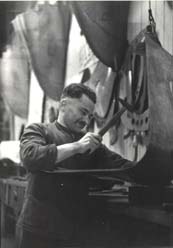 On 17 March 1933, the day the Auto Union racing department came into being, August Jakob (who had been leading the Horch research department since 1921) was commissioned to form a core team of selected craftsmen from the Horch factory. These would have to be dependable workers, trained by goldsmith Horch, people who knew all about their work: pipe fitters, panel beaters, mechanics, technicians. The department comprised of six working groups (today one would say teams):
On 17 March 1933, the day the Auto Union racing department came into being, August Jakob (who had been leading the Horch research department since 1921) was commissioned to form a core team of selected craftsmen from the Horch factory. These would have to be dependable workers, trained by goldsmith Horch, people who knew all about their work: pipe fitters, panel beaters, mechanics, technicians. The department comprised of six working groups (today one would say teams):
- the engine group
- the drivetrain and axle constructors
- the chassis group
- the plumbers, welders and fettlers
- the tooling and spare parts group
- the transport group
From the start the department consisted of 60 people, later this became 75, with 90 to 100 in its heyday. Apart from research engineer August Jakob, Franz Ischinger (later responsible for the Ingolstadt production line) and Franz Meier were appointed as engineers. The workshop was led by Otto Langsteiner, with Wilhelm Sebastian as head of the mobile workshop.
Within the Auto Union organization the Rennwagenversuchsabteilung ("race car research department") was part of the Sektor Werbung, Nachrichten, Sport (the advertising, press and sports sector), which was supervised by Dr.jur. Richard Völter. In reality the department reported straight to the board. Dr. Richard Bruhn made the financial calls, and usually these were very strict, while Dr. William Werner decided on technical matters. Until 1935 ex-Mercedes man Willy Walb was head of department, while contractually Ferdinand Porsche remained its leader. Walb signed up as racing manager and race car research manager on March 27. One more name needs to be mentioned here: on Porsche's recommendation Eberan-Eberhorst was appointed engine research engineer with Auto Union on 1 June 1933. Of course, Eberan would become Porsche's successor after the latter's contract had run out in 1937.
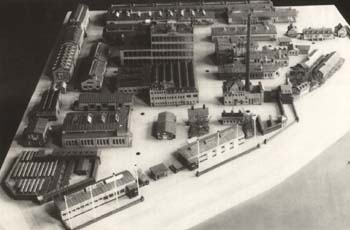
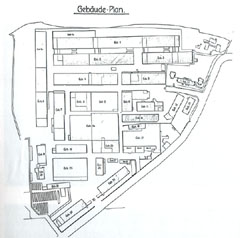
The racing department was housed in a small building on the outer fringes of the Horch works. On the map (click for a larger image) it's building 11.
After the team was put in place and the money started pouring in, the crew went about building a first car to Porsche's design. Most parts had to be created within the racing department itself. Contrary to Mercedes practice the department was regarded as an independent workshop within the factory. It did not have any company support - in fact, in those first few months of the company's existence there was no "company" as such. Most of the time Porsche would come to Zwickau to oversee the progress on his "Type 22" himself. In the summer of 1933 the racing department worked around the clock every day, performing in three shifts. The engine had to be finished, the bodywork had to be moulded and beaten into shape. In August the first engine made its debut and it had the right sound from the start. A Horch 8-cylinder engine served as a starter motor. The test engine fired up immediately, its shafts and pistons moving as they should for some two solid hours until it started to smoke. The next day it was put on the dyno and produced an encouraging 200hp at 4500rpm. With the engine running satisfactorily the team shifted their attention to the drivetrain and the bodywork, which was also basically developed at Porsche.
In November 1933 time had arrived for the future racing team and their first race-ready chassis to leave Zwickau for the Nürburgring. With Bruhn keeping a tight budget the team had six support vehicles at their disposal, two Horch 830BL, two Horch 780B and two DKW Meisterklasse. One of the 830s, equipped with a trailer coupling, was put in front of the trailer carrying the future Silver Arrow. However, just a few miles out Walb couldn't resist taking the car off its trailer and drive it on the open road! Sadly, a radiator leak quickly put an end to that. At the Nürburgring the damage was repaired and from 13 to 21 November 1933 the car was put through its paces. The whole circus took place under the utmost secrecy - SA troops hid Auto Union's efforts away from all too inquisitive eyes.
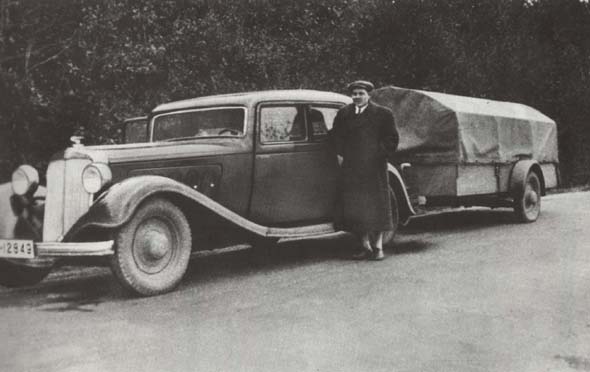
The first race car transports were done with this Horch 830 and a trailer.
The knowledge gained was put to good use on the team's return to Zwickau, and the new developments were tested at the AVUS on 12 January 1934. Here, near the heart of Berlin, it was impossible to throw up any more smoke screens - the first rumours started to emerge in the press. Again Walb was the first to touch the steering wheel, as the former Benz Tropfenwagen driver knew most about the dynamics of a rear-engined vehicle. Porsche left the AVUS extremely pleased with the test results - the car had fulfilled his contractual obligations.
Because of bad weather the team left Berlin to stage further tests at Monza. Meanwhile the racing department had completed a second car which was also dispatched to Monza. Three days after their future opponents Mercedes had finished their aerodynamic tests on the Milan-Como autostrada the Auto Union started on its development programme at Monza. Actually, the programme was planned to run until January 30 but was extended to February 5. Each day 40 laps were covered, almost reaching a Grand Prix length of 400kms - an ambitious target in testing. The main issues tested by Eberan-Eberhorst were various supercharger lay-outs and constructions. On January 31 Porsche ordered a race simulation, obliging drivers Walb, Stuck and zu Leiningen to join each other on the track. Stuck was able to reach 252kph, thereby topping the top speed that Auto Union had demanded from Porsche. It couldn't get any better, and so the decision was made to prolong the testing session. During a meeting of the supervisory board the directors then decided to build four cars: "Mr von Oertzen put forward his case that the new racing car was so well advanced that four more cars should be built - one practice car and three race cars."
On March 6 came the previously announced world speed record attempt on the AVUS, which attracted lots of bigwigs from the fields of politics, sports and technology: Major Brückner, NSKK chief Hühnlein, the German crown prince and Audi driver Wilhelm von Preussen. During the first roll-out the chief Auto Union representatives were also present, among them Horch and Audi founder August Horch, now member of the new Auto Union's supervisory board, chief engineer Willy Walb, Ernst Günter Burggaller and general director von Oertzen. They all saw Hans Stuck, Auto Union's number-one driver, set new a one-hour record (at 217.110kph), 200kms record (at 217.018kph) and 100-mile record (at 216.875kph).
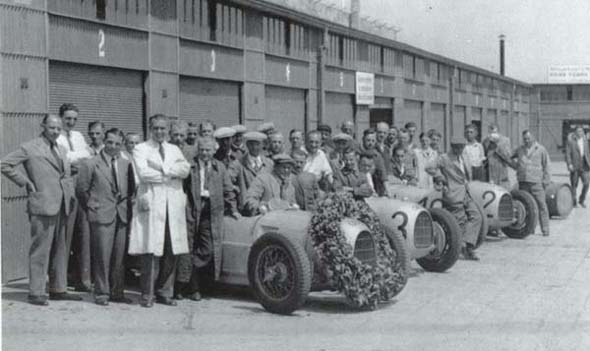
On the road to success: race manager Walb pictured with Eberan-Eberhorst, shortly after the 1934 German GP. Three cars have been prepared.
Soon the small racing department made logistical improvements as well. Taking into account the track conditions in those days, the required engine maintenance intervals and the varying track characteristics, everything had to be planned meticulously - who would drive which machine at which track in what set-up? In the short period between 5 August and 10 October Auto Union had ten events on the calendar, so with a limited number of cars available the racing department always had to stretch their resources - on the one hand they had to be present at the tracks with sufficient cars and parts to test and race, on the other hand they needed to push the technical envelope and create new modifications all the time, not necessarily with the cars present at the workshop. Apart from that, the cars had to be modified according to the track conditions - this applied especially to the hillclimb events. The company spending was enormous, costs exploded. We can deduce from the records that one race car, without the costs of actually entering it in races, had a price tag of 50,000 Reichsmarks, a huge amount of money at the time, an amount that couldn't be covered by the State subsidies. These unforseen expenses and the payments to Porsche led to some acrimony, and although his knowledge and technical prowess were highly regarded by all in the racing department, Porsche wasn't exactly a popular figure in the boardroom at Zwickau. Despite that, their first year of competition had been highly and unexpectedly successful, and even though the racing department had already stopped entertaining the thought of building five new cars, five instead of four cars were actually built. The main reason for this may have been that the long-tail version was still in use during the AVUS world record attempts and the first two races, while the bodywork entered more refined stages later on. Also, the tight schedule might have pushed the department into "putting another one on top". World record runs, hillclimbs, high-speed races, test sessions - they all forced the department into putting more cars at the disposal of the racing team.
Costs versus subsidies in the Auto Union period of 1933-1939*
| Annual costs in RM | Subsidies | Prize money | Percentage of subsidies and prize money covering costs |
| 1933'/34: 1,381,550 |
350,000 | 42,857 | 28.4 |
| 1934'/35: 1,901,192 |
450,000 | 38,000 | 23.0 |
| 1935'/36: 2,260,881 |
400,000 | 75,000 | 21.0 |
| 1936'/37: 2,692,273 |
455,000 | 61,000 | 19.5 |
| 1937'/38: 2,400,346 |
450,000 | 17,000 | 19.5 |
| 1938/'39: 2,548,371 |
375,000 | 26,000 | 15.7 |
| Totals: 13,184,613 |
2,699,857 | 20.4 | |
| 1939/'40: ? |
300,000 | ||
| 1940/'41: ? |
300,000 | ||
* Peter Kirchberg, Grand Prix Report, Berlin 1984
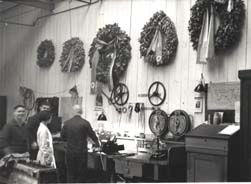 There was no respite for the racing department during the winter months of 1934/'35. On the one hand they worked at improving the concept of the car and its engine. For one thing, the cooling ducts through the chassis were badly in need of a new design, even one that would make the car gain weight. On the other hand it was found that the team needed better drivers to complement Stuck - everyone agreed that in a battle of endurance Stuck alone could not match the strong phalanx of Mercedes drivers. On 14 November the first goals were set: the driving squad would consist of Stuck, Varzi, Leiningen, Pietsch and Rosemeyer, all of whom would compete in 14 events. The team badly wanted to sign Nuvolari but Stuck put his contractual veto to good use here. It soon became apparent that such a strong squad deserved to have more cars at their disposal: the first of the new chassis should be completed in February while the last of eight new cars would have to be ready by July. Meanwhile August Momberger switched to the Werksportabteilung at the Rösslerstrasse, although he remained faithful to the driving force through offroad and test drives.
There was no respite for the racing department during the winter months of 1934/'35. On the one hand they worked at improving the concept of the car and its engine. For one thing, the cooling ducts through the chassis were badly in need of a new design, even one that would make the car gain weight. On the other hand it was found that the team needed better drivers to complement Stuck - everyone agreed that in a battle of endurance Stuck alone could not match the strong phalanx of Mercedes drivers. On 14 November the first goals were set: the driving squad would consist of Stuck, Varzi, Leiningen, Pietsch and Rosemeyer, all of whom would compete in 14 events. The team badly wanted to sign Nuvolari but Stuck put his contractual veto to good use here. It soon became apparent that such a strong squad deserved to have more cars at their disposal: the first of the new chassis should be completed in February while the last of eight new cars would have to be ready by July. Meanwhile August Momberger switched to the Werksportabteilung at the Rösslerstrasse, although he remained faithful to the driving force through offroad and test drives.
One day ahead of these formalities Porsche Sr, Porsche Jr, Walb and Eberan-Eberhorst had already agreed on the car enhancements that were needed for the 1935 season. Despite of their successful first season all saw a serious need to act, especially to improve reliability but also to be in a position to influence race strategy. For example, the tank capacity was increased from 170 litres in 1933 to 190 litres to limit the number of pitstops, allowing the car to race for 320km at a stretch. Later the capacity was further increased to 210 litres. This was enough, as the tyre degradation was enormous. This way the mechanics could refuel the car while changing tyres. Also, the planned cooling ducts through the chassis frame were scrapped after Stuck had repeatedly burnt his feet, the spaceframe suffering from an overly enthusiastic amount of heat development.
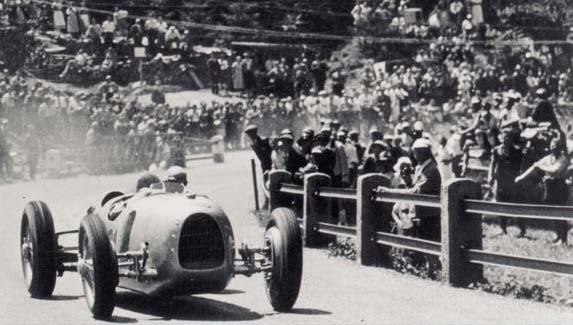
Several types of cars were needed for the variety of events Auto Union contested, as you couldn't compare hillclimbs with high-speed record attempts. The team had a lot of work on their hands to manufacture the varying axles, drivetrains and fuel tanks needed to cope with this diversity. Here Hans Stuck is seen on his way to victory in the Kesselberg hillclimb in an Auto Union Typ A/B hillclimber on 30 June 1935. Picture: Audi Tradition.
On 22 January 1935 Walb and Eberan gave an extensive progress report to the board. Soon after, the racing department was forced to make a U-turn, as internal finances had made it clear that it was only slightly more expensive to rebuild three of the old cars into '35-spec machines and build four new ones than to go with the original plan of turning all five old cars around and adding three pukka 1935 chassis. However, to achieve this, the racing department would need the help of the Horch factory. For this, the Horch factory was obliged to produce several special parts within the time frame laid out by the racing department. Among these were brake, axle and engine parts that were produced on the same tooling machines as were used for the Horch limousine serial production.
 Moreover, the racing department would be confronted with the vanities of propaganda. Of course, the world record runs were fine arguments. But even then, the department was suffering under the stress of continuing cost reduction and reorganising. Their rooms were furnished economically while their transport fleet was only enlarged by two Büssing-Nag trucks of which one had already been put to use in 1934 as a mobile workshop. On the technical front, everything was tried to create new capabilities, although for example the windtunnel tests in Windkanal Berlin Adlerhorst were usually performed using scale models and only seldom with real-size cars, as for instance with the Lucca type.
Moreover, the racing department would be confronted with the vanities of propaganda. Of course, the world record runs were fine arguments. But even then, the department was suffering under the stress of continuing cost reduction and reorganising. Their rooms were furnished economically while their transport fleet was only enlarged by two Büssing-Nag trucks of which one had already been put to use in 1934 as a mobile workshop. On the technical front, everything was tried to create new capabilities, although for example the windtunnel tests in Windkanal Berlin Adlerhorst were usually performed using scale models and only seldom with real-size cars, as for instance with the Lucca type.
Several weeks after the board decision to create the new cars from serial-production parts from the Horch factory many components were still missing. There was no question of completing the first car in time. The racing department was faced with a Catch 22 - although they had been given the money for a fourth new car, the board had been foolish to believe that the serial production team would be the racing department's best ally. The racing department was in need of great flexibility to allow for the quick technical changes required in a motorsport environment, while their dependence on a production line would always lead to compromise, as it focused completely on strict working practices and had to cope with ever increasing demands due to the economic upswing. And this should be the main supplier to the racing department? In a missive dated 11 March 1935 Walb made it clear to the board that both the Horch factory and the external Porsche bureau did not make sufficient effort to complete the car on its due date. With it, the service crews were drawn away from the racing department to attend the races and thus were missing at home.
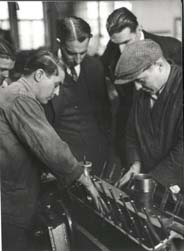 In all, not a good start to the new racing season - and what was worse, they hadn't been napping all winter at Stuttgart. Au contraire. Mercedes-Benz would soon fly from one victory to another, putting more pressure on Zwickau, and especially on Walb. And so the inevitable happened. While Dr. Porsche pushed the new racing car to perfection Auto Union appointed a new head of the racing department, Dr. rer.pol. Karl Feuereissen, on 1 September 1935, pushing Walb a step down the hierarchy. Although Walb had been allowed to continue as technical director and race manager at the tracks, Feuereissen had already been promised the prize money as part of his contract - funds that in all honesty were still due to Walb. And so, on Christmas Eve, the board decided to transfer Walb to the Wanderer plant at Siegmar to oversee the development of the supercharged Wanderer W25K. Understandably, Walb became a deeply bitter man. His knowledge of supercharger development and the improvements he made to the Wanderer supercharger design were neither recognized nor acknowledged. Walb wouldn't have anything to do with the racing department for the rest of his life - and even went to court to claim unpaid wages. That was the end of it, and for the W25K as well, which had been thought as a worthy adversary to the BMW 328 but never outgrew its status as a boulevard roadster due its poor handling and lack of performance.
In all, not a good start to the new racing season - and what was worse, they hadn't been napping all winter at Stuttgart. Au contraire. Mercedes-Benz would soon fly from one victory to another, putting more pressure on Zwickau, and especially on Walb. And so the inevitable happened. While Dr. Porsche pushed the new racing car to perfection Auto Union appointed a new head of the racing department, Dr. rer.pol. Karl Feuereissen, on 1 September 1935, pushing Walb a step down the hierarchy. Although Walb had been allowed to continue as technical director and race manager at the tracks, Feuereissen had already been promised the prize money as part of his contract - funds that in all honesty were still due to Walb. And so, on Christmas Eve, the board decided to transfer Walb to the Wanderer plant at Siegmar to oversee the development of the supercharged Wanderer W25K. Understandably, Walb became a deeply bitter man. His knowledge of supercharger development and the improvements he made to the Wanderer supercharger design were neither recognized nor acknowledged. Walb wouldn't have anything to do with the racing department for the rest of his life - and even went to court to claim unpaid wages. That was the end of it, and for the W25K as well, which had been thought as a worthy adversary to the BMW 328 but never outgrew its status as a boulevard roadster due its poor handling and lack of performance.
And so Walb's competence trickled away, a human tragedy within the walls of the Auto Union concern. What was Feuereissen capable of that Walb could not do? Perhaps it was his better representation of the company. Feuereissen was a former member of the ADAC sports department (the ADAC is the German automobile club) and for 1935 he was formally appointed as a consultant and organizer of races and other sporting events while in fact he acted as Walb's successor, as Walb had difficulty in shedding his test driver skin. Walb was not to blame for this, as his job profile had been established back in 1933. But with the successes this had changed and Walb had failed to grow with it. As early as 1 February 1936 Walb was also shown the door at Wanderer, after which he was transferred to the goverment-liaison department that was put in place to keep close ties with the Nazi party. In economical terms this was an interesting function, which Walb represented on behalf of the technical sales department, acting as an account manager to prominent Auto Union drivers within government, party and army ranks. In the end, Walb stayed with Auto Union until it was dissolved, a tragic coda to a technical career that started off euphorically.
In 1935 Auto Union decided to create a Zentrales Konstruktionsburo (Central Design Bureau) at Chemnitz, almost putting a full stop behind the history of the racing department. The ZKB had been an idea of interim board member Werner, its purpose being the integration of the independent design departments located within the various factories, thereby creating a single design face for the Auto Union marque instead of the four disparate Auto Union companies. From today's point of view this was modern thinking, in those days it was a necessity on the grounds of costs that almost killed off the racing department. It is said that William Werner told August Jakob, head of the Horch research effort to whom Eberan-Eberhorst now had to report, "to keep a watchful eye on den Ebern ("the swine"), as he's an evil little fellow", when discussing Eberan's proposed budgets for materials tests. But in the end the racing department would remain independent, and although it had to keep the brakes on as far as costs were concerned, the innovation brakes would be left untouched.

The full logistical effort of 1935. The Auto Union team were often on the road, carrying the cars and the mechanics to racing events. Usually the team was away from home at Zwickau for weeks.
Eberan-Eberhorst had the following to say on the economical approach that the board demanded from the racing department: "This (being economic) forced us into an extremely meticulous design methodology. While the people at Mercedes-Benz always had money to spend in spades, the Saxons were strapped for cash all of the time. It wasn't just that we didn't have the funds, we also lacked spare parts. Mercedes used to turn up at races with eight transporters, while Auto Union started out with just the one. Later this grew to three." And so Eberan concluded that, "When we are supposed to lose races, then we should aim at doing so in advance, in our research effort." What he was saying was that Auto Union's racing department could only beat Mercedes on the track if it was significantly better at research and development. And so Auto Union offered competition through their meticulous technical approach, thus compensating for Mercedes' big-money effort. Only through numerous practice runs, detail changes and raw material tests could the concept of the Auto Union racing car function properly.
Soon the racing department also had an engine test bank with whirlpool brakes for aeroplanes at their disposal, as well as vibration and friction measuring machines and an installation designed to test various track conditions. The windtunnel tests at the Berlin Windkanal were a part of the equation too. It's not too difficult to imagine the busy times the racing department went through, especially at the times when several co-workers came along to the races acting either as service engineers or as pit mechanics. Or at the times when others were moved to Stuttgart to join the efforts of radiator supplier BEHR. Of course, not all of the racing department's people were present at the races, nor was Eberan-Eberhorst, but nonetheless many of the fitters and plumbers were found in the pits working on the cars as they prepared for practice, made overnight repairs, and finalized set-ups. And in between racing days they would act as truck drivers transporting their valuable goods from San Sebastian to Brno to set up practice camp - all in the spirit of economy.
After three years the racing department had seen many ups and downs:
- they had successfully completed the design of a competitive racing machine - from the drawing board to the race track.
- they had lost their race manager due to the strategic ponderings of their board of directors.
- they had lived through a highly successful debut year in 1934, followed by a less successful 1935 season.
Building on their experience, the subsequent changes to their organizational structure and equipment and with new innovations coming up the Auto Union racing department prepared for the 1936 season.
Bibliography
- Beinhorn, Elly: Mein Mann der Rennfahrer, München, Berlin 1984.
- Cameron, Earl; Die Akte Silberpfeile, Königswinter 2000.
- Cancellieri, De Agostini, Schröder; Auto Union - Die grossen Rennen, Hannover 1979.
- Etzold, Rother, Erdmann; Im Zeichen der Vier Ringe, Ingolstadt 1992.
- Kieselbach, Ralf; Technik der Eleganz, Berlin 1999.
- Kirchberg, Peter; Bildatlas Auto Union, Stuttgart 1987.
- Kirchberg, Peter; Grand Prix Report, Berlin 1987.
- Kirchberg, Peter; Horch, Audi, DK, IFA, 80 Jahre Autos aus Zwickau, Stuttgart 1988.
- Knittel, Stefan; Auto Union Grand Prix Rennwagen, München 1980.
- Maurer, Hermann; Das Zusammenschlussproblem der deutschen Automobilindustrie mit besonderer Berücksichtigung der Auto Union AG, Diss. Zürich 1934.
- Nixon, Chris, Racing the Silver Arrows, London 1986.
- Pönisch, Jürgen; 100 Jahre Horch Automobile, Zwickau 1999.
- Pönisch, Jürgen; August Horch – Pionier der Kraftfahrt, Zwickau 1999.
- Pönisch, Jürgen; August Horch – Pionier des Automobils, Radebeul 1993.
- Rauch, Siegfried; DKW, Die Geschichte einer Weltmarke, Stuttgart 1988.
- Stuck, Hans; Zweimal Hans Stuck, Stuttgart 1972.
- Vann, Peter, and others; Neusilber, Stuttgart 2001.
- various authors; "Das Rad der Zeit", Ingolstadt, several annuals.
- various Auto Union AG in-house magazines, author's collection.
- various undisclosed manuscripts, various articles from the Automobil Revue, conversations with Prof. Kirchberg, Thomas Erdmann and former workers at the Rennabteilung in 1992 at Chemnitz, Auto Union Archiv, August Horch Museum Zwickau, Sächsisches Staatsarchiv, and the Atlas F1 Nostalgia Forum.

